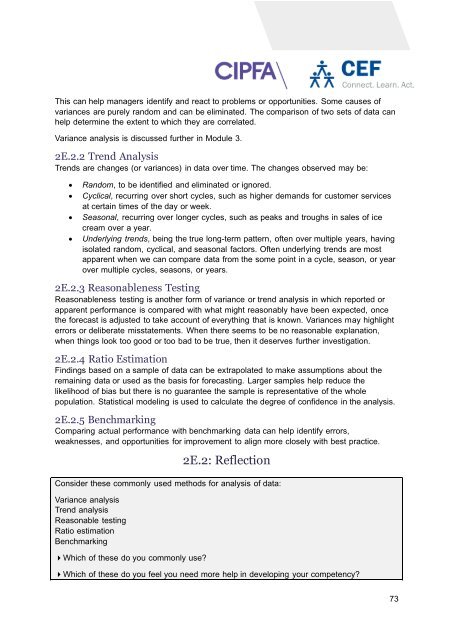TIAPS ALB_Module 2E. Data Analytics for Internal Auditing
- No tags were found...
You also want an ePaper? Increase the reach of your titles
YUMPU automatically turns print PDFs into web optimized ePapers that Google loves.
This can help managers identify and react to problems or opportunities. Some causes of<br />
variances are purely random and can be eliminated. The comparison of two sets of data can<br />
help determine the extent to which they are correlated.<br />
Variance analysis is discussed further in <strong>Module</strong> 3.<br />
<strong>2E</strong>.2.2 Trend Analysis<br />
Trends are changes (or variances) in data over time. The changes observed may be:<br />
• Random, to be identified and eliminated or ignored.<br />
• Cyclical, recurring over short cycles, such as higher demands <strong>for</strong> customer services<br />
at certain times of the day or week.<br />
• Seasonal, recurring over longer cycles, such as peaks and troughs in sales of ice<br />
cream over a year.<br />
• Underlying trends, being the true long-term pattern, often over multiple years, having<br />
isolated random, cyclical, and seasonal factors. Often underlying trends are most<br />
apparent when we can compare data from the some point in a cycle, season, or year<br />
over multiple cycles, seasons, or years.<br />
<strong>2E</strong>.2.3 Reasonableness Testing<br />
Reasonableness testing is another <strong>for</strong>m of variance or trend analysis in which reported or<br />
apparent per<strong>for</strong>mance is compared with what might reasonably have been expected, once<br />
the <strong>for</strong>ecast is adjusted to take account of everything that is known. Variances may highlight<br />
errors or deliberate misstatements. When there seems to be no reasonable explanation,<br />
when things look too good or too bad to be true, then it deserves further investigation.<br />
<strong>2E</strong>.2.4 Ratio Estimation<br />
Findings based on a sample of data can be extrapolated to make assumptions about the<br />
remaining data or used as the basis <strong>for</strong> <strong>for</strong>ecasting. Larger samples help reduce the<br />
likelihood of bias but there is no guarantee the sample is representative of the whole<br />
population. Statistical modeling is used to calculate the degree of confidence in the analysis.<br />
<strong>2E</strong>.2.5 Benchmarking<br />
Comparing actual per<strong>for</strong>mance with benchmarking data can help identify errors,<br />
weaknesses, and opportunities <strong>for</strong> improvement to align more closely with best practice.<br />
<strong>2E</strong>.2: Reflection<br />
Consider these commonly used methods <strong>for</strong> analysis of data:<br />
Variance analysis<br />
Trend analysis<br />
Reasonable testing<br />
Ratio estimation<br />
Benchmarking<br />
Which of these do you commonly use?<br />
Which of these do you feel you need more help in developing your competency?<br />
73
















